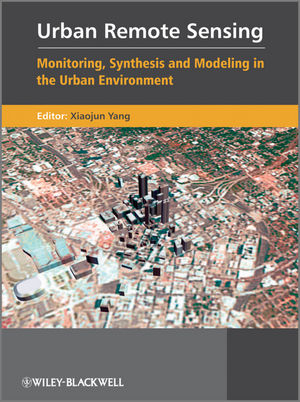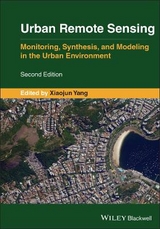
Urban Remote Sensing
Wiley-Blackwell (Verlag)
978-0-470-74958-6 (ISBN)
- Titel ist leider vergriffen;
keine Neuauflage - Artikel merken
Xiaojun Yang has authored or co-authored more than 70 publications including two edited volumes on urban remote sensing. He was a guest editor for ISPRS Journal of Photogrammetry and Remote Sensing, Photogrametrical Engineering and Remote Sensing, International Journal of Remote Sensing, and Computer, Environment and Urban Systems. Yang has been involved in organizing urban remote sensing sessions at the annual meetings of the Association of American Geographers (AAG) since 2001. This series of events has become a major urban remote sensing forum in USA. Yang currently serves as Chair of Commission on Mapping for Satellite Imagery, International Cartographic Association (ICA).
List of Contributors xiii Author s Biography xvi Preface xix PART 1 INTRODUCTION 1 1 What is urban remote sensing? 3 Xiaojun Yang 1.1 Introduction 4 1.2 Remote sensing and urban studies 5 1.3 Remote sensing systems for urban areas 6 1.4 Algorithms and techniques for urban attribute extraction 7 1.5 Urban socioeconomic analyses 7 1.6 Urban environmental analyses 8 1.7 Urban growth and landscape change modeling 8 Summary and concluding remarks 9 References 10 PART 2 REMOTE SENSING SYSTEMS FOR URBAN AREAS 13 2 Use of archival Landsat imagery to monitor urban spatial growth 15 Xiaojun Yang 2.1 Introduction 16 2.2 Landsat program and imaging sensors 16 2.3 Mapping urban spatial growth in an American metropolis 18 2.4 Discussion 27 3 Limits and challenges of optical very-high-spatial-resolution satellite remote sensing for urban applications 35 Paolo Gamba, Fabio Dell Acqua, Mattia Stasolla, Giovanna Trianni and Gianni Lisini 3.1 Introduction 36 3.2 Geometrical problems 36 3.3 Spectral problems 38 3.4 Mapping limits and challenges 38 3.5 Adding the time factor: VHR and change detection 39 3.6 A possible way forward 39 3.7 Building damage assessment 43 Conclusions 46 References 47 4 Potential of hyperspectral remote sensing for analyzing the urban environment 49 Sigrid Roessner, Karl Segl, Mathias Bochow, Uta Heiden, Wieke Heldens and Hermann Kaufmann 4.1 Introduction 50 4.2 Spectral characteristics of urban surface materials 50 4.3 Automated identification of urban surface materials 54 4.4 Results and discussion of their potential for urban analysis 58 References 60 5 Very-high-resolution spaceborne synthetic aperture radar and urban areas: looking into details of a complex environment 63 Fabio Dell Acqua, Paolo Gamba and Diego Polli 5.1 Introduction 64 5.2 Before spaceborne high-resolution SAR 64 5.3 High-resolution SAR 66 Conclusions 70 Acknowledgments 70 References 70 6 3D building reconstruction from airborne lidar point clouds fused with aerial imagery 75 Jonathan Li and Haiyan Guan 6.1 Lidar-drived building models: related work 76 6.2 Our building reconstruction method 77 6.3 Results and discussion 85 Concluding remarks 89 Acknowledgments 90 References 90 PART 3 ALGORITHMS AND TECHNIQUES FOR URBAN ATTRIBUTE EXTRACTION 93 7 Parameterizing neural network models to improve land classification performance 95 Xiaojun Yang and Libin Zhou 7.1 Introduction 96 7.2 Fundamentals of neural networks 96 7.3 Internal parameters and classification accuracy 100 7.4 Training algorithm performance 105 7.5 Toward a systematic approach to image classification by neural networks 107 8 Characterizing urban subpixel composition using spectral mixture analysis 111 Rebecca Powell 8.1 Introduction 112 8.2 Overview of SMA implementation 112 8.3 Two case studies 118 Conclusions 124 Acknowledgments 126 References 126 9 An object-oriented pattern recognition approach for urban classification 129 Soe W. Myint and Douglas Stow 9.1 Introduction 130 9.2 Object-oriented classification 130 9.3 Data and study area 133 9.4 Methodology 134 9.5 Results and discussion 137 Conclusion 139 References 140 10 Spatial enhancement of multispectral images on urban areas 141 Bruno Aiazzi, Stefano Baronti, Luca Capobianco, Andrea Garzelli and Massimo Selva 10.1 Introduction 142 10.2 Multiresolution fusion scheme 144 10.3 Component substitution fusion scheme 144 10.4 Hybrid MRA component substitution method 146 10.5 Results 147 Conclusions 152 References 152 11 Exploring the temporal lag between the structure and function of urban areas 155 Victor Mesev 11.1 Introduction 156 11.2 Micro and macro urban remote sensing 156 11.3 The temporal lag challenge 157 11.4 Structural functional links 157 11.5 Temporal structural functional links 159 11.6 Empirical measurement of temporal lags 159 Conclusions 161 References 161 PART 4 URBAN SOCIOECONOMIC ANALYSES 163 12 A pluralistic approach to defining and measuring urban sprawl 165 Amnon Frenkel and Daniel Orenstein 12.1 Introduction 166 12.2 The diversity of definitions of sprawl 166 12.3 Historic forms of urban sprawl 168 12.4 Qualitative dimensions of sprawl and quantitative variables for measuring them 169 Conclusion 178 References 178 13 Small area population estimation with high-resolution remote sensing and lidar 183 Le Wang and Jose-Silvan Cardenas 13.1 Introduction 184 13.2 Study sites and data 185 13.3 Methodology 186 13.4 Results 187 Discussion and conclusions 192 Acknowledgments 192 References 192 14 Dasymetric mapping for population and sociodemographic data redistribution 195 James B. Holt and Hua Lu 14.1 Introduction 196 14.2 Dasymetric maps, dasymetric mapping, and areal interpolation 196 14.3 Application example: metropolitan Atlanta, Georgia 200 Conclusions 205 Acknowledgments 208 References 208 15 Who's in the dark-satellite based estimates of electrification rates 211 Christopher D.Elvidge, Kimberly E. Baugh, Paul C. Sutton, Budhendra Bhaduri, Benjamin T. Tuttle, Tilotamma Ghosh, Daniel Ziskin and Edward H. Erwin 15.1 Introduction 212 15.2 Methods 212 15.3 Results 213 15.4 Discussion 214 Conclusion 223 Acknowledgments 223 References 223 16 Integrating remote sensing and GIS for environmental justice research 225 Jeremy Mennis 16.1 Introduction 226 16.2 Environmental justice research 226 16.3 Remote sensing for environmental equity analysis 227 16.4 Integrating remotely sensed and other spatial data using GIS 229 16.5 Case study: vegetation and socioeconomic character in Philadelphia, Pennsylvania 230 Conclusion 234 References 235 PART 5 URBAN ENVIRONMENTAL ANALYSES 239 17 Remote sensing of high resolution urban impervious surfaces 241 Changshan Wu and Fei Yuan 17.1 Introduction 242 17.2 Impervious surface estimation 242 17.3 Pixel-based models for estimating high-resolution impervious surface 243 17.4 Object-based models for estimating high-resolution impervious surface 249 Conclusions 252 References 252 18 Use of impervious surface data obtained from remote sensing in distributed hydrological modeling of urban areas 255 Frank Canters, Okke Batelaan, Tim Van de Voorde, Jaros^3aw Chormanski and Boud Verbeiren 18.1 Introduction 256 18.2 Spatially distributed hydrological modeling 256 18.3 Impervious surface mapping 257 18.4 The WetSpa model 258 18.5 Impact of different approaches for estimating impervious surface cover on runoff calculation and prediction of peak discharges 261 Conclusions 270 Acknowledgments 270 References 270 19 Impacts of urban growth on vegetation carbon sequestration 275 Tingting Zhao 19.1 Introduction 276 19.2 Vegetation productivities and estimation 276 19.3 Data and analysis 277 19.4 Results 280 19.5 Discussion 283 Conclusions 284 Acknowledgments 284 References 285 20 Characterizing biodiversity in urban areas using remote sensing 287 Marcus Hedblom and Ulla Mortberg 20.1 Introduction 288 20.2 Remote sensing methods in urban biodiversity studies 288 20.3 Hierarchical levels and definitions of urban ecosystems 292 20.4 Using remote sensing to interpret effects of urbanization on species distribution 294 20.5 Long-term monitoring of biodiversity in urban green areas methodology development 295 20.6 Applications in urban planning and management 296 Conclusions 297 Acknowledgments 300 References 300 21 Urbanweather, climate and air quality modeling: increasing resolution and accuracy using improved urbanmorphology 305 Susanne Grossman-Clarke, William L. Stefanov and Joseph A. Zehnder 21.1 Introduction 306 21.2 Physical approaches for the representation of urban areas in regional atmospheric models 306 21.3 Remotely sensed data as input for regional atmospheric models 307 21.4 Case studies investigating the effects of urbanization on weather, climate and air quality 311 Conclusions 316 Acknowledgments 316 References 316 PART 6 URBAN GROWTH AND LANDSCAPE CHANGE MODELING 321 22 Cellular automata and agent base models for urban studies: from pixels to cells to hexa-dpi's 323 Elisabete A. Silva 22.1 Introduction 324 22.2 Computation: the raster pixel aproach 324 22.3 Cells: migrating from basic pixels 324 22.4 Agents: joining with cells 327 22.5 Cells and agents in a computer s artificial life 328 22.6 The hexa-dpi: closing the cycle in the digital age 330 Conclusions 332 References 332 23 Calibrating and validating cellular automata models of urbanization 335 Paul M. Torrens 23.1 Introduction 336 23.2 Calibration 336 23.3 Validating automata models 339 Conclusions 341 Acknowledgments 342 References 342 24 Agent-based urban modeling:simulating urban growth and subsequent landscape change in suzhou, china 347 Yichun Xie and Xining Yang 24.1 Introduction 348 24.2 Design, construction, calibration, and validation of ABM 348 24.3 Case study desakota development in Suzhou, China 350 24.4 The Suzhou Urban Growth Agent Model 351 Summary and conclusion 354 References 355 25 Ecological modeling in urban environments: predicting changes in biodiversity in response to future urban development 359 Jeffrey Hepinstall-Cymerman 25.1 Introduction 360 25.2 Predicting changes in land cover and avian biodiversity for an area north of Seattle, Washington 362 Conclusions 365 Acknowledgments 367 References 368 26 Rethinking progress in urban analysis and modeling: models, metaphors, and meaning 371 Daniel Z. Sui 26.1 Introduction 372 26.2 Pepper s world hypotheses: the role of root metaphors in understanding reality 373 26.3 Progress in urban analysis and modeling: metaphors urban modelers live by 373 26.4 Models, metaphors, and the meaning of progress: further discussions 377 Summary and concluding remarks 377 Acknowledgments 378 Notes 378 References 378 Index 383
| Verlagsort | Hoboken |
|---|---|
| Sprache | englisch |
| Maße | 221 x 281 mm |
| Gewicht | 1478 g |
| Themenwelt | Naturwissenschaften ► Geowissenschaften ► Geografie / Kartografie |
| ISBN-10 | 0-470-74958-X / 047074958X |
| ISBN-13 | 978-0-470-74958-6 / 9780470749586 |
| Zustand | Neuware |
| Informationen gemäß Produktsicherheitsverordnung (GPSR) | |
| Haben Sie eine Frage zum Produkt? |
aus dem Bereich



